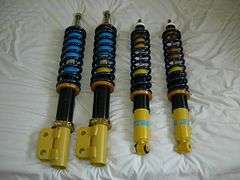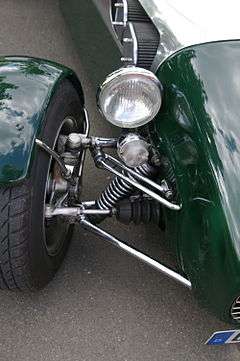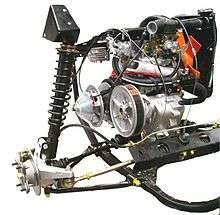Coilover



A coilover is an automobile suspension device. The design of a coilover is similar to that of a MacPherson strut, but features a spring that encircles the damper, rather than sitting on top of it.[1] The name coilover is short for "coil-over shock absorber".[2]
Description
A coilover consists of a shock absorber with a coil spring encircling it. The shock absorber and spring are assembled as a unit prior to installation, and are replaced as a unit when the shock absorber has leaked. This provides damping without torsional loads. Some coilovers allow adjustment of ride height and preload, using a simple threaded spring perch similar to a nut. More advanced adjustable coilover systems use a threaded shock body, along with an adjustable lower mount for ride height adjustment, while an adjustment knob is used to adjust damping. Stiffness can be changed by switching the spring for one with a different spring rate.[3]
The coilover style of spring placement is used in the double wishbone suspension,[4] and is often a component of the MacPherson strut suspension system.[5]
Two of the main types of coilovers are full coilovers and slip on coilovers. Full coilovers are matched up with a shock from the factory, while with slip on coilovers, the dampers and springs are bought separately and then assembled.[6]
Coilovers are found on many vehicles, from RC cars to normal passenger cars, race cars and 4x4 vehicles. They are sometimes used as a factory suspension option on new cars. Many aftermarket companies also make coilovers for vehicles, many of which allow the customer to adjust various settings such as ride height, damping, rebound and camber angle. Coilovers can be used to lower the center of gravity of the vehicle to reduce weight transfer when the vehicle is going through turns at high speeds.
Components
Coilovers are made up of several components, including the shock absorber, coil spring, bushings, bumpstop, upper and lower mount, jam nuts, various nuts and washers, and collars.[7]
See also
References
- ↑ "Will Coilovers Improve My Car's Handling? | YourMechanic Advice". www.yourmechanic.com. Retrieved 2018-06-10.
- ↑ Steve Hendrickson Gerry Burger. Hot Rodder's Bible : The Ultimate Guide to Building Your Dream Machine. MotorBooks International. pp. 179–. ISBN 978-1-61060-963-0.
- ↑ Keith Tanner (2 December 2010). How to Build a High-Performance Mazda Miata MX-5. Motorbooks. pp. 113–. ISBN 978-1-61060-970-8.
- ↑ Julian Happian-Smith (2001). An Introduction to Modern Vehicle Design. Elsevier. pp. 285–. ISBN 978-0-7506-5044-1.
- ↑ Tim Gilles (2005). Automotive Chassis: Brakes, Suspension, and Steering. Cengage Learning. pp. 329–. ISBN 1-4018-5630-6.
- ↑ "Coilovers vs Springs – What are coilovers and what's better?". www.aptuned.com. Retrieved 2018-06-10.
- ↑ "How A Coilover Works - Super Street Magazine". SuperStreetOnline. 2013-04-09. Retrieved 2018-04-25.
External links
- http://www.pirate4x4.com/tech/billavista/coilovers/Part_1/, in-depth explanation of coilovers and their function.
- "http://www.pirate4x4.com/tech/billavista/coilovers/Part_2/"
- http://www.corbymotorsport.com/tuning_guide.php, article related to setting up coilovers
- http://accutuneoffroad.com/articles/shock-tuning-101/, how to tune rebuildable coilovers